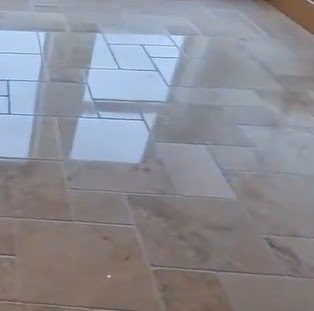Travertine Tile Cleaning
What is Travertine?
Travertine is a type of sedimentary rock that is a form of limestone deposited by mineral springs.
It is formed by rapid precipitation of calcium carbonate, often at the mouth of a hot spring or in a limestone cave.
It is characterized by its pitted holes and troughs in its surface, although many installers and homeowners prefer to fill these holes with grout to create a smoother surface.
Travertine comes in various hues and patterns and is commonly used in building materials for flooring, wall coverings, and countertops.
Its porous nature makes it suitable for certain environments, as it provides a natural, non-slip surface, but it also requires regular maintenance and sealing to prevent staining and etching.
The Origins of Travertine
Travertine is a type of limestone that forms around mineral spring deposits.
It has been used for centuries in buildings and monuments worldwide.
Its natural variations in color and texture make it a unique and attractive option for flooring, countertops, and other surfaces.
Characteristics of Travertine
Travertine is known for its porous surface, which gives it a textured, non-slip finish. However, these pores can also collect dirt and grime, making it necessary to clean and seal the tiles regularly. Additionally, travertine is sensitive to acidic substances, which can etch the surface and cause damage.
Essential Tips for Travertine Tile Cleaning
Here are some essential tips for cleaning travertine tile:
This will help prevent the buildup of grime, which can make it more difficult to clean later.
Avoid harsh chemicals or acidic cleaners, as these can damage the travertine.
This will help you ensure the cleaner does not damage the travertine.
Here are some additional tips:
- Use a microfiber mop to clean the travertine tile. Microfiber mops are gentle on the tile's surface and can pick up dirt and dust effectively.
- If you have grout lines, clean them regularly with a grout cleaner.
Grout cleaners can help to remove dirt, mold, and mildew from the grout lines. - You may need a professional cleaner if you have a stubborn stain.
Several professional cleaners are specifically designed for travertine tile.
Following these tips can keep your travertine tile looking beautiful for years.
Deep Cleaning
- Use a pH-neutral cleaner specifically designed for natural stone.
Avoid using acidic or alkaline cleaners, as they can damage the surface of the travertine.
- Dilute the cleaner according to the manufacturer's instructions and apply it to the surface using a mop or sponge. Make sure to wring out excess water to avoid over-saturating the tiles.
Addressing Stains
- A mixture of baking soda and water can be applied to the affected area for light stains.
Leave the paste on the stain for 10-15 minutes, then gently scrub with a soft brush and rinse thoroughly.
- For more stubborn stains, it may be necessary to use a poultice.
A poultice is a paste made of a cleaning agent and an absorbent material like talc or kaolin clay.
Apply the poultice to the stain, cover with plastic wrap, and leave it overnight. Remove the poultice and rinse the area thoroughly.
Drying and Buffing
- After cleaning, thoroughly dry the surface using a clean mop or towel. This will prevent water spots and streaks from forming.
- Buff the surface with a clean, dry cloth to restore its natural shine.
Sealing Travertine Tiles
Why Sealing is Necessary
Sealing is essential in travertine tile maintenance as it helps fill the stone's pores, making it less susceptible to staining and etching.
Additionally, a good-quality sealer will enhance the natural colors of the travertine and give it a glossy finish.
How to Seal Travertine Tiles
- Make sure the surface is clean and dry before sealing.
Any dirt, grime, or moisture on the surface can cause the sealer to not adhere properly.
- Apply the sealer using a foam brush or a soft cloth.
Apply it evenly across the surface, paying special attention to the grout lines.
- Allow the sealer to dry according to the manufacturer's instructions.
It is usually recommended to wait at least 24 hours before using the surface.
Regular Maintenance is Key
Regular maintenance is crucial to keep your travertine tiles looking their best.
Following these simple tips and tricks ensures that your travertine surfaces remain beautiful and durable for years.
Types of Travertine Tile and Its Uses.
Vein-cut travertine:
Tumbled travertine:
This type of travertine is given a rough, rustic finish by tumbling it in a rotating drum with abrasives. It is often used for flooring, walls, and patios.
Honed travertine: This type of travertine is given a smooth, even finish by polishing it with a machine.
It is often used for countertops, backsplashes, and other surfaces that require a high-gloss finish.
Filled travertine: This type of travertine has had its pores filled with resin or grout to make it more resistant to staining. It is often used for flooring and countertops.
Travertine tiles are in various colors, including white, beige, brown, and gray.
They can also be found with different veining patterns.
The best type of travertine tile for your project will depend on your budget, the desired finish, and the intended use.
Here are some additional considerations when choosing travertine tiles:
- Porosity: Travertine is a porous stone that can absorb liquids and stains. Filled travertine is less porous than unfilled travertine, but sealing all travertine tiles to prevent staining is still important.
- Hardness: Travertine is a relatively soft stone, so avoiding using abrasive cleaners or scrubbers is important.
- Maintenance: Travertine tiles require regular cleaning and sealing to maintain their appearance.
Check out our article How Marble Loses Its Shine.







.png)

